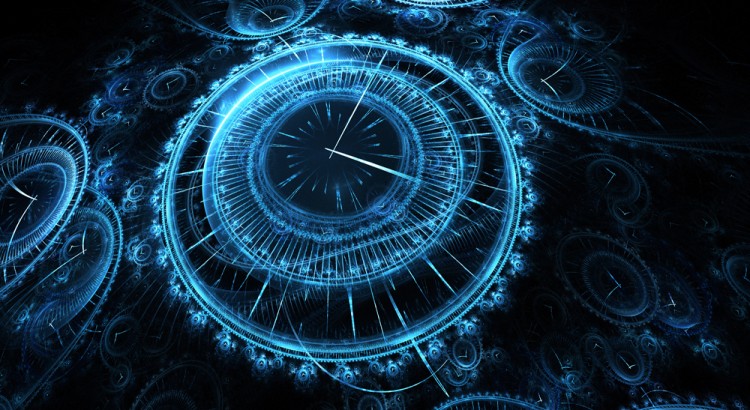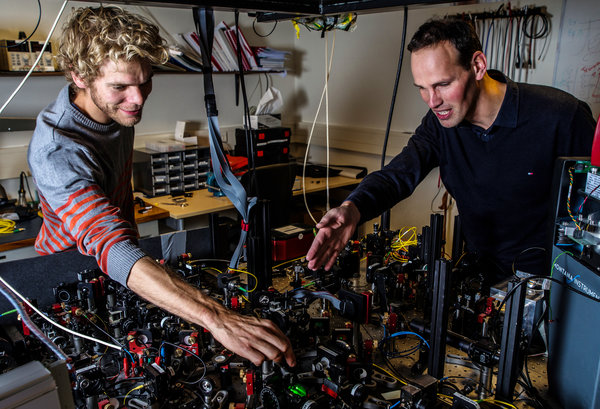 In a landmark study, scientists at Delft University of Technology in Netherlands reported that they had conducted an experiment that they say proved one of the most fundamental claims of quantum theory — that objects separated by great distance can instantaneously affect each other’s behavior.
In a landmark study, scientists at Delft University of Technology in Netherlands reported that they had conducted an experiment that they say proved one of the most fundamental claims of quantum theory — that objects separated by great distance can instantaneously affect each other’s behavior.
The finding is another blow to one of the bedrock principles of standard physics known as «locality», which states that an object is directly influenced only by its immediate surroundings. The Delft study, published Wednesday in the journal Nature, lends further credence to an idea that Einstein famously rejected. He said quantum theory necessitated «spooky action at a distance», and he refused to accept the notion that the universe could behave in such a strange and apparently random fashion.
In particular, Einstein derided the idea that separate particles could be «entangled» so completely that measuring one particle would instantaneously influence the other, regardless of the distance separating them.
Einstein was deeply unhappy with the uncertainty introduced by quantum theory and described its implications as akin to God’s playing dice.
But since the 1970s, a series of precise experiments by physicists are increasingly erasing doubt — alternative explanations that are referred to as loopholes — that two previously entangled particles, even if separated by the width of the universe, could instantly interact.
The new experiment, conducted by a group led by Ronald Hanson, a physicist at the Dutch university’s Kavli Institute of Nanoscience, and joined by scientists from Spain and England, is the strongest evidence yet to support the most fundamental claims of the theory of quantum mechanics about the existence of an odd world formed by a fabric of subatomic particles, where matter does not take form until it is observed and time runs backward as well as forward.

Bas Hensen, left, and Ronald Hanson helped show that objects apart can instantly affect each other. Credit Frank Auperle/Delft University of Technology
The researchers describe their experiment as a «loophole-free Bell test» in a reference to an experiment proposed in 1964 by the physicist John Stewart Bell as a way of proving that «spooky action at a distance» is real.
«These tests have been done since the late ’70s but always in the way that additional assumptions were needed», Dr. Hanson said. «Now we have confirmed that there is spooky action at distance».
According to the scientists, they have now ruled out all possible so-called hidden variables that would offer explanations of long-distance entanglement based on the laws of classical physics.
The Delft researchers were able to entangle two electrons separated by a distance of 1.3 kilometers, slightly less than a mile, and then share information between them. Physicists use the term «entanglement» to refer to pairs of particles that are generated in such a way that they cannot be described independently. The scientists placed two diamonds on opposite sides of the Delft University campus, 1.3 kilometers apart.
Each diamond contained a tiny trap for single electrons, which have a magnetic property called a «spin». Pulses of microwave and laser energy are then used to entangle and measure the «spin» of the electrons.
The distance — with detectors set on opposite sides of the campus — ensured that information could not be exchanged by conventional means within the time it takes to do the measurement.
«I think this is a beautiful and ingenious experiment and it will help to push the entire field forward», said David Kaiser, a physicist at M.I.T., who was not involved in the study. However, Dr. Kaiser, who is with another group of physicists who are preparing to perform an even more ambitious experiment next year that will soon measure light captured at the far edges of the universe, also said he did not think every scintilla of doubt had been erased by the Dutch experiment.
The tests take place in a mind-bending and peculiar world. According to quantum mechanics, particles do not take on formal properties until they are measured or observed in some way. Until then, they can exist simultaneously in two or more places. Once measured, however, they snap into a more classical reality, existing in only one place.
Beyond the immediate result, physicists noted that the experiment represented an advance in the understanding of a Lilliputian world that was once largely the province of theory. Quantum mechanics has already had a huge impact on modern technology and industry. For example, it is the foundation for modern computers and lasers.
«What I do find interesting is that the experimenters are learning how to manipulate quantum systems, and do experiments that are far beyond what was possible when I was starting in physics», said Leonard Susskind, a theoretical physicist at Stanford. «Things which were at best ‘thought experiments» become possible, then routine. That is incredibly impressive».
Indeed, the experiment is not merely a vindication for the exotic theory of quantum mechanics, it is a step toward a practical application known as a «quantum Internet». Currently, the security of the Internet and the electronic commerce infrastructure is fraying in the face of powerful computers that pose a challenge to encryption technologies based on the ability to factor large numbers and other related strategies.
Researchers like Dr. Hanson envision a quantum communications network formed from a chain of entangled particles girdling the entire globe. Such a network would make it possible to securely share encryption keys, and know of eavesdropping attempts with absolute certainty.
For some physicists, even though the new experiment claims to be «loophole free», the matter is not completely closed.
«The experiment has closed two of the three major loopholes beautifully, but two out of three isn’t three», Dr. Kaiser said. «I believe in my bones that quantum mechanics is the correct description of nature. But to make the strongest statement, frankly we’re not there».
A potential weakness of the experiment, he suggested, is that an electronic system the researchers used to add randomness to their measurement may in fact be predetermined in some subtle way that is not easily detectable, meaning that the outcome might still be predetermined as Einstein believed.
To attempt to overcome this weakness and close what they believe is a final loophole, the National Science Foundation has financed a group of physicists led by Dr. Kaiser and Alan H. Guth, also at M.I.T., to attempt an experiment that will have a better chance of ensuring the complete independence of the measurement detectors by gathering light from distant objects on different sides of the galaxy next year, and then going a step further by capturing the light from objects known as quasars near the edge of the universe in 2017 and 2018.




